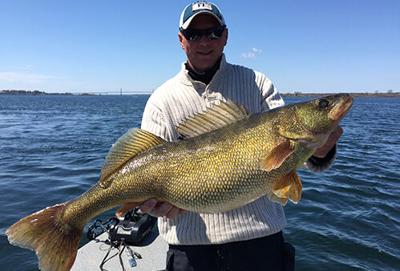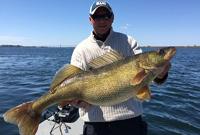Since the walleye season opened on the first Saturday in May, I have spoken to a number ‘eye anglers who fish the Mohawk River, Great Sacandaga Lake and Saratoga Lake. On each of these occasions I have managed to squeeze out a few of their secrets, but all of them were rather vague with revealing their exact locations. The following is what I was able to pry out of them.
The walleye, like any of the other freshwater game fish, are structure-oriented, but that is not all that attracts them there. It is the schools of baitfish that frequent the area. These areas are many, but those that I heard most frequently were drops along the channel edges close to the deeper water, deep weedy bottoms, shoals, humps coming sharply up from the deeper water, rocks and riprap. Add to this the fluctuations in water temperatures, oxygen, PH levels and light penetration. This is why the majority of successful walleye angler’s boats are equipped with electronic LCD fish/depth finders.
Now if you are fishing for river walleye where there is generally a current, the ‘eyes are a bit more predictable. Their primary holding areas are usually in current breaks, the slack water behind islands, bridge abutments, and along the sides of the dam. However, when fishing the dam areas STAY BEHIND THE DANGER buoys. Position your boat so you can drift your lure/bait offerings past these structures.
For those without a depth finder, especially on new water, they suggest you use a good contour map of the lake/river before going fishing. One of the best maps for this is the Fishing Hot Spot maps. These maps are very detailed and can give you the areas where walleye are found. But I still recommend an LCD unit to not only find the spot, but also actually see the fish.
One other excellent source of finding where the walleye bite is the local bait and tackle shops. They think and talk fishing every day, and they can be a great help to you even if it is not your first time on the lake/river.
There are a number of techniques, lures and live bait used when walleye fishing. The most popular appears to be trolling. This technique allows you to cover a lot of water. There are a number of lure choices for trolling, but in the group I interviewed they all like the old June Bug Spinner trailed with a nightcrawler on one rod. They all use one rod without any weight added to the spinner, and another with a split shot or two to get the spinner down deep. The other bait used is stick baits like the Rapalas, Bombers, etc. Just be sure to vary your depths, and always have a buoy marker nearby.
As for the speed, they all agreed to going just fast enough to keep the spinners spinning and the stick baits wiggling. Two of the anglers I spoke with at the Great Sacandaga Lake had boats equipped with speedometers. And both said the ideal speed range should be from 1.5 to 2.5 mph. Also, you should always have a buoy marker and when you get a strike immediately throw it out. “Do not run away from fish!” Walleye are a schooling breed and they will either troll back and forth over the area where you caught the fish. You can also try jigging the area with live bait.
The jig choices will vary from 1/8 to 1/2 ounces,and the more popular colors are black, white, yellow. If in a rocky area try brown/orange which is the color of crayfish. Those fishing live bait generally use a Lindy Rig to fish leeches, nightcrawlers and minnows. The hook sizes will vary from No. 4 to No. 6. Those I spoke with all were using fluorocarbon leaders. And if you Google “walleye dinner,” you will find plenty of recipes.
TALKIN’ BASS
The Saratoga Bass Challenge kicked off its first team afternoon tournament of the season on Saratoga Lake with 47 teams, 41 of which weighed in fish. Leading the way with 14.14 pounds was Bill Goodermote of Brunswick and James Sausville of Grafton, worth $1,058. That is about $210 a fish. Second place and $634 was Saratoga anglers Dave Munger and John Jenkins with 12.71 pounds. In third place was Saratoga angler’s PJ Peculis and Henry Marchell with 12.10 pounds worth $423. The lunker bass of the tournament was a 4.71 pound largemouth by Saratoga anglers Jeff Russell and Dan Dyer, which earned them $470.
This past Sunday the Mohawk Valley Angler held their 3-man tournament Mohawk River going out of the Kawanis Park Launch site There were nine teams that competed. Winners were the Rotterdam team of Chris Collins, Chris Collins Jr. and Tod Keenan weighed in 10.88 pounds, which included the tournament lunker – a 3.12-pound smallmouth. They received $190. In second place was Bart and Zack Metzold of Rotterdam with 9.41 pounds, good for $120. Third and final place was Tom Barnes and Paul Marlow of Ballston Spa with 7.56 pounds ($90). All three teams weighed in five-bass limits.
Reach Gazette outdoors columnist Ed Noonan at enoonan@nycap.rr.com.









